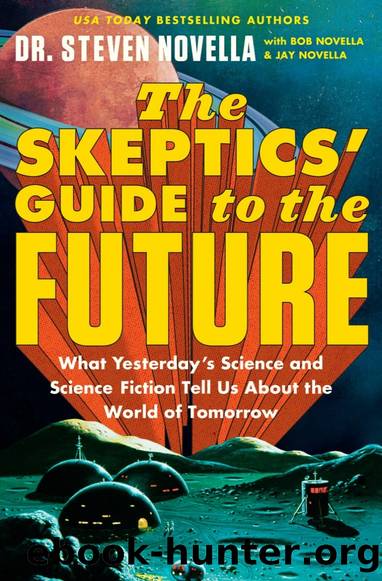The Skeptics' Guide to the Future: What Yesterday's Science and Science Fiction Tell Us About the World of Tomorrow by Steven Novella

Author:Steven Novella [Novella, Steven]
Language: eng
Format: epub
ISBN: 9781538709542
Amazon: 1538709546
Barnesnoble: 1538709546
Goodreads: 60021453
Publisher: Grand Central Publishing
Published: 2022-09-27T00:00:00+00:00
Power Production Today
Figures from 2021 published in the Economist indicate that the world mix of energy sources was coal 29.6 percent, natural gas 22.5 percent, hydroelectric 2.6 percent, nuclear 5.9 percent, petroleum products 28.6 percent, and nonhydro renewables (mostly wind, solar, geothermal, and biomass) 10.8 percent. Thatâs 80.7 percent total from fossil fuels. The mix can vary considerably for different countries. For the United States, the mix was coal 22 percent, natural gas 36 percent, all renewables 21 percent, and nuclear 20 percent (for a total fossil fuels of 58 percent).
In the United States, renewables, especially wind and solar, are rapidly trending up. Natural gas has recently increased significantly, but it is now slowly trending down. Coal is rapidly trending down. Nuclear is holding its own due to extending the license on existing nuclear power plants.
The question becomes what is our energy infrastructure going to look like by 2050, 2100, and in the far future? As we have seen with future technology in general, it all depends on the choices we make today. There are numerous factors to consider, including a couple more aspects of energy infrastructure we have yet to discuss: distribution and storage.
In addition to the source of energy, we need to consider how it will be distributed. Right now, electricity is generally centrally produced and then broadly distributed along large grids (essentially a managed web of transmission lines). In the lower forty-eight states of the United States, for example, there are three gridsâan eastern grid, a western grid, and Texas. Texas remains on its own grid to avoid interstate regulations. The largest grid in the world is the synchronous grid of Continental Europe, which serves twenty-four countries.
The advantage of large grids is that they allow for sharing energy, which makes it easier to average out peaks in demand or compensate for a loss of production. Larger grids will also make integrating intermittent sources of power, like wind and solar, easier. The wind is always blowing somewhere, so a widely connected grid could essentially turn a sporadic source of power into a reliable one. Sharing solar power would require very large grids that can transport power from sunlit parts of the world to dark parts of the world, something there are no plans for at the time of this writing.
There are a lot of calls for upgrading the various energy grids. A modernized grid can be smarter, incorporating computer technology and AI control systems to optimally balance supply with demand and prevent blackouts. Upgrades could also harden the grid against disruptions from coronal mass ejections or even attack.
Further, an upgraded grid would better allow for distributed energy production. This is one trend in energy infrastructure that can have a huge impact on the future. Instead of generating power centrally and distributing it, a larger portion of energy can be produced locally. This has several advantages. First, the power does not have to travel as far, so there is less loss in transmission. Currently an average of about 6
Download
This site does not store any files on its server. We only index and link to content provided by other sites. Please contact the content providers to delete copyright contents if any and email us, we'll remove relevant links or contents immediately.
Bad Pharma by Ben Goldacre(3355)
How To by Randall Munroe(3034)
The Book of Numbers by Peter Bentley(2912)
Aliens by Jim Al-Khalili(2787)
A Short History of Nearly Everything by Bryson Bill(2629)
The Meaning of it All by Richard Feynman(2300)
Bill Bryson by A short history of nearly everything(1679)
A Short History of Nearly Everything: Special Illustrated Edition by Bill Bryson(1634)
Elephants on Acid by Boese Alex(1565)
Six Easy Pieces by Richard P. Feynman(1491)
Everything in Its Place by Oliver Sacks(1444)
The Meaning Of It All by Richard P. Feynman(1423)
Glukhovsky, Dmitry - Metro 2033 by Glukhovsky Dmitry(1312)
Bad Science by Ben Goldacre(1297)
When Einstein Walked with Gödel by Jim Holt(1268)
One Two Three ... Infinity: Facts and Speculations of Science by George Gamow(1219)
The American Scene by Henry James(1213)
Leviathan Wakes by James S.A. Corey(1191)
A SHORT HISTORY OF NEARLY EVERYTHING by bryson bill(1186)
